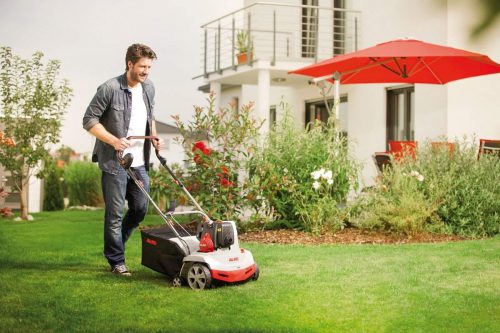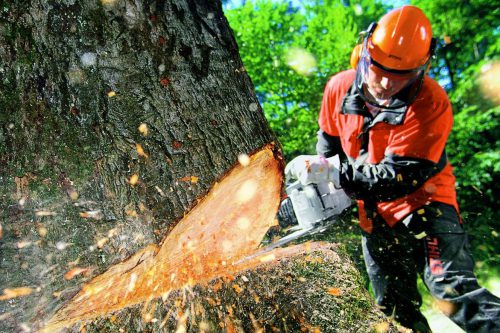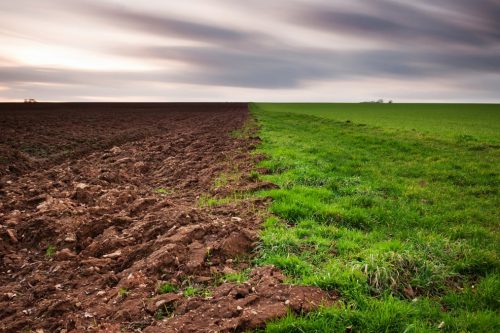Cucumbers are considered a key horticultural crop grown by summer residents throughout the country. In view of this, you need to choose the right material for planting. Most continue to use self-prepared seeds, but this is wrong, as the fruits get smaller over time.
Others, on the contrary, use hybrid varieties that are bred specifically for any climatic conditions. As a result, this rating was compiled, which included the best varieties of cucumbers in 2020. It will provide an opportunity to understand the selection of the necessary seeds, since there are a lot of them on the market.
Content
Selection of cucumber seeds
First of all, the summer resident needs to establish which varieties he needs to purchase directly - varietal or hybrid. The first variety will result from crossing plants that belong to the same type, the other (marked F1) is derived from combining different species. Varietals require more careful maintenance, but they become a source of seeds for the next season. Hybrid species are easier to care for, they are characterized by high yields and resistance to pests and diseases.
Then you should consider in what environment such crops are grown. When the cucumbers are planted in greenhouse conditions, then parthenocarpic species are suitable. They pollinate on their own, so there is no need for insects. Pollinated are the best varieties for open ground. The period of the beginning of the harvest is of key importance: special winter varieties are available for purchase, which feel great during a lack of sun - they are planted in greenhouses in the autumn, and in January they can give a fairly high harvest.
Hybrid varieties are early or late ripening. The first species will bear fruit after 2-3 months after sowing, the second - after about 4-5 months. Gardeners often prefer spring-summer varieties that are fast growing and disease resistant. In addition, you need to make a choice for what the crop is used for. When cucumbers are intended for pickling, it is required to purchase varieties with a thin skin and a dense middle. For food use, it is optimal to use cucumbers, which have a dense skin and a crispy middle of medium to large size. You can also choose universal varieties.
In the process of compiling this rating, all the details were taken into account, customer reviews, as well as the cost and quality of the seeds themselves, were taken into account.
Greenhouse varieties
These varieties are in demand in most areas with cold climates. With a cold summer, this is the main opportunity to grow homemade vegetables. But even in warm regions, growing in greenhouses makes it possible to extend the fruiting period. Below is a rating, which includes the best varieties of cucumbers for the greenhouse.
Boy with thumb F1
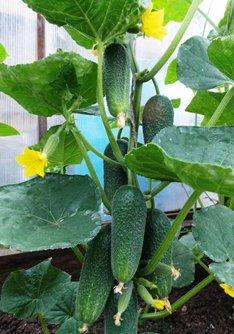
It is considered to be an early maturing variety, yielding approximately 2 months after sowing. It is classified as a hybrid, it feels great in tunnels, greenhouses and in open soil. The fruit is about 10 cm long, small bumps are present on the surface, and the weight is about 75 g.The pulp is pleasant, even in overripe vegetables there are no voids or bitterness. The seeds are rather small, almost invisible. Cucumbers have excellent taste - they can be used in food fresh or canned.
Such a variety will give an optimal yield when grown in a seedless way. At that time, it is recommended to soak them for 4-5 hours before landing in the ground. Seeds are carefully inspected before planting, you need to make sure that they are full-bodied and approximately the same size. If you comply with this condition, you will be able to achieve virtually 100% germination. Plant feeding is carried out not with chemicals, but with the help of a variety of natural means - droppings, slurry, ash, etc.
Pros:
- pleasant taste;
- big harvest;
- long-term fruiting;
- excellent resistance to various diseases.
Minuses:
- barren flowers can be found, in particular on the branches of the stem.
Alekseich F1
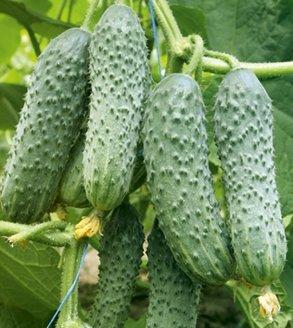
A fairly common variety among gardeners, which is distinguished by increased productivity and rapid ripening of fruits - no more than 1.5 months will pass from the emergence of seedlings to the collection of vegetables (in some cases, less, taking into account the climate and weather). Such a hybrid is pollinated on its own, it feels great under a film greenhouse or in open soil. Plants do not grow very large, side shoots are present in small numbers. Blooming in knots, each containing about 3 vegetables.
The shape of the fruit is cylindrical, elongated, green stripes are present on the skin, there are few tubercles, about 8 cm long and weighing about 70 g. The flesh is crunchy, dense, without bitterness. Vegetables are suitable for eating fresh or canned. From 1 sq. m of sowing, it is possible to collect about 14 kg. It is possible to grow as seedlings, it is allowed to plant in open soil when it warms up to 15 degrees. For 1 sq. m. it is recommended to plant no more than 5 shoots, when vegetables grow on trellises, then there will be less of them - 3-4 plants per 1 sq. m. soil. It is fertilized in advance, leaves are added before winter.
Pros:
- friendly formation of fruits, due to which high productivity is achieved;
- long-term fruiting;
- excellent disease resistance.
Minuses:
- the soil is prepared for such a variety at the end of last season.
Goosebump F1

It is one of the most versatile varieties - the plants feel great in the greenhouse and in open soil, they can also be grown on the balcony. They do not need pollination, vegetables remain fresh for a long period, bitterness does not appear, the yield is quite high. It appears already on the 40th day after landing. Medium in size, there are not very many branches.
A large number of small leaves that are smooth to the touch, barren flowers are practically absent. Long-term fruiting, plants are resistant to various diseases. But still, you need to take care of the prevention of diseases like root rot and downy mildew in time. Fruits are medium - infrequently appear more than 12 cm in length. It is possible to collect them when they become at least 8 cm. The average weight is about 100 g. They are cylindrical in shape, there are few thorns, but rather thorny. Cucumbers are good for eating and salting.
Pros:
- versatility in cultivation and in eating;
- high yield;
- long-term fruiting.
Minuses:
- resistance to not all diseases.
Benefit F1
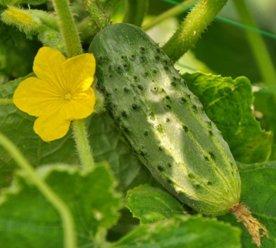
This hybrid is also classified as a high-yielding variety. In addition, they are virtually maintenance free. Refers to medium early varieties: it will take about 2 months from germination to ripening. The variety is considered self-pollinated, the flowers are predominantly female, the barren flowers are practically absent, the fruits are tied in 4-5 bundles. One bush gives about 7-8 kg of fruit. With regard to the growth conditions, the variety is universal: it grows in soil, in greenhouse conditions or in a greenhouse, fresh cucumbers are used.
It should be noted that the lash will grow lanky, therefore it must be formed during growth, in particular, when it grows on a vertical trellis. The weight of a cucumber is approximately 100 g with a length of no more than 13 cm. It has an oblong shape, there are short stripes on the skin. The taste is pleasant, there is no bitterness. Dense middle, fruits cope with long transportation, stored for a long period. Plants resistant to diseases, low temperature indicators.
Pros:
- increased yield;
- resistance to low temperature;
- unpretentiousness when leaving.
Minuses:
- lanky lash, it is compulsorily formed, otherwise it will negatively affect the harvest.
Sankin love F1

It is the most productive hybrid of all the best varieties of cucumbers of the current year - fruiting will begin early and continue for a fairly long period of time. Plants of the female type of flowering practically do not branch, which greatly simplifies care. It blooms in knots, one containing about 12 vegetables. It is believed that this type is the best varieties of cucumbers for pickling and preservation, but it is also suitable for fresh consumption: there is no bitterness, the skin is thin and dense, the middle is crunchy.
On the surface there are pronounced bumps, the length of cucumbers reaches approximately 9-10 cm, they perfectly tolerate transportation over long distances. In addition, their resistance to the following diseases should be noted: olive spot, common mosaic virus. Immune to various types of powdery mildew, including downy mildew.
Experienced gardeners advise to mold plants into only 1 stem - in this way they will receive the necessary amount of light, and all the nutritional components will enter the ovary. Then, when the first crop is harvested, you need to feed the cucumbers with products with an increased concentration of nitrogen. They grow at a distance from each other - by 1 sq. m it is permissible to plant no more than 2 shoots. This variety requires abundant watering, without fail using warm water. The harvest is removed every day - if you follow such instructions, it is possible to achieve a record harvest: from 1 sq. m it is possible to collect about 40 kg of fruits during the season.
Pros:
- high yield;
- disease resistance;
- slight spreading of the bushes.
Minuses:
- not installed.
The best frost-resistant varieties
To grow such fruits in the northern regions, mainly varieties are used that can withstand sharp climate changes and do not require high temperatures. Only varieties that mature quickly will do as the summer is short.
Serpentine

A fairly productive variety that can withstand low temperature indicators. Vegetables ripen early, perfect for preservation, as well as for direct consumption. The bushes are quite powerful, not long, side lashes are presented in small numbers, characterized by a female flowering. It will take approximately 1.5 months from planting to harvesting the first crop. The shape is elongated, resembles a cylinder, and reaches about 12 cm in length.
Outwardly very beautiful, the middle crunches, without the slightest hint of bitterness, pleasant smell. The skin is thin, the average weight is 80 g. It is possible to get about 20 kg from one bush, but when the weather and climate allow, this figure will be improved to 25 kg. The variety bears fruit for a long time - throughout the summer. They are planted in the soil in May, the seeds are not soaked in advance, there should be approximately 30 cm of distance between the plants.
Pros:
- high yield;
- beautiful in appearance;
- juicy inside;
- long period of storage and transportation;
- not picky.
Minuses:
- there are a large number of thorns on the fruits, therefore they are washed with a special brush.
Competitor

This variety is classified by professionals as early ripening - the first vegetables can be obtained after about 1.5-2 months. Sowing is carried out in May, when temperatures are already positive at night.The stem grows pretty quickly, has tendrils, so it is great for trellises. The leaves are medium, shaped like a heart. Flowering begins quite quickly - almost after the appearance of 5-6 leaves. The variety requires pollination. The yield is average, closer to low - only 3-4 kg per 1 sq. m. Fruiting is long and is equal to about 3 months. It is sometimes longer and shorter, taking into account the weather and climate. There were situations when the lashes bore fruit in mid-October.
The fruits have a standard shape, dark green in color. Cucumbers are predominantly large - they reach 18 cm in length and weigh about 160 g. This will greatly facilitate harvesting. The taste is good, there is no bitterness, the pulp is somewhat sweetish, juicy. They can be eaten fresh and canned, both separately and in combination with other vegetables.
Pros:
- non-hybrid variety, because the seeds are used for planting next year;
- great taste;
- pickiness.
Minuses:
- elongated whips;
- low yield.
Altaic

It is a fairly hardy plant, lashes and roots can withstand significant cold. The length of the whip is small, it can be approximately 80 cm, therefore for 1 sq. m it is possible to plant about 5 plants - they will not interfere with the growth of others. The skin of vegetables is quite dense, in the middle they are soft, therefore it is recommended to eat them only fresh. The fruits themselves look like an ellipse, there are practically no tubercles on the surface, the color is light green, they reach about 10 cm in length, but you can also find rather large fruits - including up to 15 cm.
The vegetables in question are medium in taste, the cucumbers themselves begin to taste bitter in a situation where there is an insufficient amount of moisture. The variety is classified as fast-ripening. The harvest is average, but sufficient for food. Plants do not need any special soil preparation, they are grown even in rather lean soil, poor in nutrients.
Pros:
- resistance to low temperature indicators;
- pickiness;
- long fruiting period.
Minuses:
- suitable only for fresh food.
Nezhinsky

It is another varietal option that perfectly withstands the short-term effect of low temperature indicators. It is classified as pollinated, it does not ripen very quickly - after the emergence of seedlings, it will take about 2 months. Scourges sometimes reach about 2 m in length. The leaves are bright green in color and small in size. Average yield - about 13 kg per 1 sq. m. Taste characteristics are high: the middle has a characteristic aroma for cucumbers, bitterness does not appear even with a small amount of moisture. The skin is quite dense, there are a large number of sharp black thorns, the weight of the vegetable is no more than 100 g.
Prior to planting, agronomists recommend disinfecting the seeds by placing them in a manganese solution for a day. This makes it possible to prevent the occurrence of root diseases. Landing is allowed in fairly cool ground - about 10 degrees. Watering is carried out approximately 1 time per 7 days, after the emergence of seedlings, fertilizing is carried out with agents that contain nitrogen, magnesium and phosphorus.
Pros:
- perfect for any climate;
- able to withstand low temperatures, as well as drought;
- fruits easily tolerate transportation;
- plants are immune to a variety of diseases.
Minuses:
- not installed.
Bush
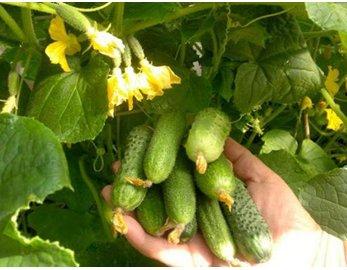
It is another rather compact variety of the best cucumbers of the current year - its maximum length of the lash is no more than 70 cm, in total there are no more than 2-3 side lashes. Such a plant is great for a small area where there is not enough land to plant the desired crop. The variety in question is referred to as parthenocarpic, which is why it is grown in greenhouses, but the yield in greenhouses will be much less than in open soil.Cucumbers are early ripening - the harvest is removed already after 3 weeks after the appearance of the initial shoots.
The length of the vegetables is not too long - no more than 12 cm with a weight of about 100 g. It resembles an egg in shape, somewhat elongated. Great for canning, however, it is also suitable for eating fresh. Taste characteristics are excellent - the pulp is extremely juicy and crunchy, the skin is not very dense. It is possible to grow by seedling or seed method, but in the first situation, the harvest will be received much earlier - planting in the soil is carried out in the last days of May or at the beginning of summer. At the end of planting, until the plants have taken root in the ground, they need to be covered with a film overnight. Adult plants are not afraid of temperature drops and cold nights, in addition, they are immune to a variety of diseases.
Pros:
- pickiness;
- does not need a lot of planting space;
- excellent taste characteristics;
- good resistance to a variety of diseases.
Minuses:
- fruiting will end after about 5-6 weeks.
The choice of delicious cucumbers that will delight you with a large yield and do not cause a significant number of problems during cultivation is a significant problem for most summer residents. New hybrid varieties are emerging with enviable consistency. It's hard not to get confused among such a variety of species. In this regard, this rating was compiled, which included the best varieties of cucumbers in the current year, taking into account the feedback from experts and gardeners.



